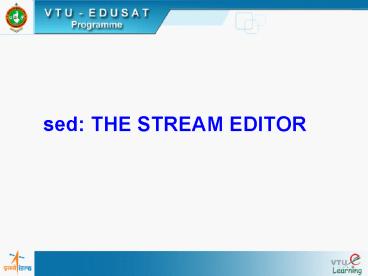sed: THE STREAM EDITOR - PowerPoint PPT Presentation
1 / 19
Title:
sed: THE STREAM EDITOR
Description:
Sed supports inserting (i), appending (a), changing (c) and deleting (d) commands for the text ... Text editing. Inserting, appending, changing and deleting ... – PowerPoint PPT presentation
Number of Views:60
Avg rating:3.0/5.0
Title: sed: THE STREAM EDITOR
1
- sed THE STREAM EDITOR
2
In the last class,
- grep filter
- Different options
- Regular expressions
- Basic regular expressions
- Extended regular expressions
3
In this class,
- sed to edit an input stream and understand its
addressing mechanism - Line addressing
- Using multiple instructions
- Context addressing
- Writing selected lines to a file
- Text editing
- Inserting, changing and deleting lines
4
INTRODUCTION
- sed is a multipurpose tool which combines the
work of several filters - sed uses instructions to act on text. An
instruction combines an address for selecting
lines, with an action to be taken on them. - sed options address action file(s)
- sed supports only the BRE set
5
- Address specifies either one line number to
select a single line or a set of two lines, to
select a group of contiguous lines - action specifies print, insert, delete,
substitute the text
6
LINE ADDRESSING
- sed 3q emp.lst
- Just similar to head n 3 emp.lst. Selects first
three lines and quits - sed n 1,2p emp.lst
- p prints selected lines as well as all lines. To
suppress this behavior, we use n whenever we use
p command - sed n p emp.lst
- Selects last line of the file
7
- sed n 9,11p emp.lst
- Selecting lines from anywhere of the file,
between lines from 9 to 11 - sed n 1,2p
- 7,9p
- p emp.lst
- Selecting multiple groups of lines
- sed n 3,!p emp.lst
- Negating the action, just same as 1,2p
8
USING MULTIPLE INSTRCUTIONS
- There is adequate scope of using the e and f
options whenever sed is used with multiple
instructions - sed n e 1,2p e 7,9p e p emp.lst
- Let us consider,
- cat instr.fil
- 1,2p
- 7,9p
- p
9
- -f option to direct the sed to take its
instructions from the file - sed n f instr.fil emp.lst
- We can combine and use e and f options as many
times as we want - sed n f instr.fil1 f instr.fil2 emp.lst
- sed n e /saxena/p f instr.fil1 f
instr.fil2 emp.lst
10
CONTEXT ADDRESSING
- We can specify one or more patterns to locate
lines - sed n /director/p emp.lst
- We can also specify a comma-separated pair of
context addresses to select a group of lines - sed n /dasgupta/,/saxena/p emp.lst
- Line and context addresses can also be mixed
- sed n 1,/dasgupta/p emp.lst
11
Using regular expressions
- Context addresses also uses regular expressions
- Sed n /aAggararwal/p emp.lst
- Selects all agarwals
- Sed n /sakxsena/p
- /gupta/p emp.lst
- Selects saxenas and gupta
12
- We can also use and , as part of the regular
expression syntax - sed n /50../p emp.lst
- Selects all people born in the year 1950
13
WRITING SELECTED LINES TO A FILE
- We can use w command to write the selected lines
to a separate file - sed n /director/w dlist emp.lst
- Saves the lines of directors in dlist file
- sed n /director/w dlist
- /manager/w mlist
- /executive/w elist emp.lst
- Splits the file among three files
14
- sed n 1,500w foo1
- 501,w foo2 foo.main
- Line addressing also. Saves first 500 lines in
foo1 and the rest in foo2
15
TEXT EDITING
- Sed supports inserting (i), appending (a),
changing (c) and deleting (d) commands for the
text - sed 1i\
- gt include ltstdio.hgt\
- gt include ltunistd.hgt
- gt foo.c gt
- Will add two include lines in the beginning of
foo.c file. Sed identifies the line without the \
as the last line of input. Redirected to
temporary file
16
- This technique has to be followed when using the
a and c commands also - To insert a blank line after each line of the
file is printed (double spacing text), we have - sed a\
- emp.lst
17
Deleting lines (d)
- sed /director/d emp.lst gt olist
or - sed n /director/!p emp.lst gt olist
- Selects all lines except those containing
director, and saves them in olist - Note that n option not to be used with d
18
SUMMARY
- sed A multipurpose toolkit and can combine
several filters - Line addressing
- Using multiple instructions
- Context addressing
- Writing selected lines to a file
- Text editing
- Inserting, appending, changing and deleting lines
19
- THANK YOU































